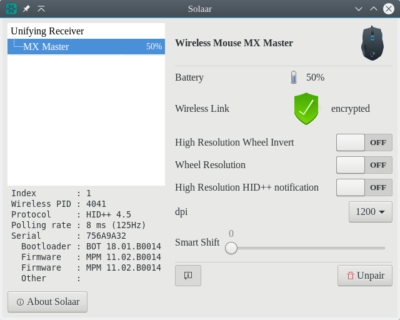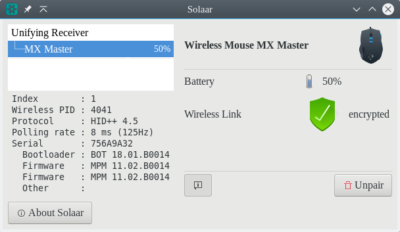While going through Fedora’s Tagger, I came across a package called Solaar, a Linux device manager for Logitech’s Unifying Receiver.
I thought “Well, this could be pretty useful” because until the little lights on my MX Master mouse start flashing red, I never know the charge status of the mouse.
Installing the package with dnf install solaar gave me a taskbar icon, but for some reason it didn’t find any devices to manage. After poking around in the Solaar installation documentation, it looked like my problem was that the Fedora package didn’t install the udev rules that allow non-root access to the Logitech Unifying Receiver.
Once I added the rules file and a new user group, Solaar was able to find the MX Master and show me its status.
Working pretty well so far, and it’s nice being able to see the charge status of my mouse. Doesn’t let me configure buttons or change DPI settings, but maybe that’s something I can convince solaar to do.
~/workspace> solaar show
Unifying Receiver
Device path : /dev/hidraw4
USB id : 046d:c52b
Serial : 89629F0B
Firmware : 12.03.B0025
Bootloader : 02.15
Other : AA.AA
Has 1 paired device(s) out of a maximum of 6.
Notifications: wireless, software present (0x000900)
Device activity counters: 1=130
1: Wireless Mouse MX Master
Codename : MX Master
Kind : mouse
Wireless PID : 4041
Protocol : HID++ 4.5
Polling rate : 8 ms (125Hz)
Serial number: 756A9A32
Bootloader: BOT 18.01.B0014
Firmware: MPM 11.02.B0014
Firmware: MPM 11.02.B0014
Other:
The power switch is located on the base.
Supports 29 HID++ 2.0 features:
0: ROOT {0000}
1: FEATURE SET {0001}
2: DEVICE FW VERSION {0003}
3: DEVICE NAME {0005}
4: WIRELESS DEVICE STATUS {1D4B}
5: RESET {0020}
6: BATTERY STATUS {1000}
7: CHANGE HOST {1814}
8: REPROG CONTROLS V4 {1B04}
9: ADJUSTABLE DPI {2201}
10: VERTICAL SCROLLING {2100}
11: SMART SHIFT {2110}
12: HIRES WHEEL {2121}
13: GESTURE 2 {6501}
14: DFUCONTROL 2 {00C1}
15: unknown:1813 {1813} internal, hidden
16: unknown:1830 {1830} internal, hidden
17: unknown:1890 {1890} internal, hidden
18: unknown:18A1 {18A1} internal, hidden
19: unknown:18C0 {18C0} internal, hidden
20: unknown:1DF3 {1DF3} internal, hidden
21: unknown:1E00 {1E00} hidden
22: unknown:1EB0 {1EB0} internal, hidden
23: unknown:1803 {1803} internal, hidden
24: unknown:1861 {1861} internal, hidden
25: unknown:9000 {9000} internal, hidden
26: unknown:9200 {9200} internal, hidden
27: unknown:9240 {9240} internal, hidden
28: unknown:1805 {1805} internal, hidden
Battery: 50%, discharging.
Update: Ended up running into some issues with the taskbar icon reverting back to not detecting any devices. This is apparently a known issue, so I cloned the Solaar repo and pulled in some of the PRs that are supposed to address the issue. Copied the files to where they were installed on the system (/usr/lib/python2.7/site-packages/) and restarted the app. Solaar picked up the mouse, and even some options for configuring the mouse, including DPI control. Woot! So far, no more problems with Solaar suddenly forgetting the mouse.

